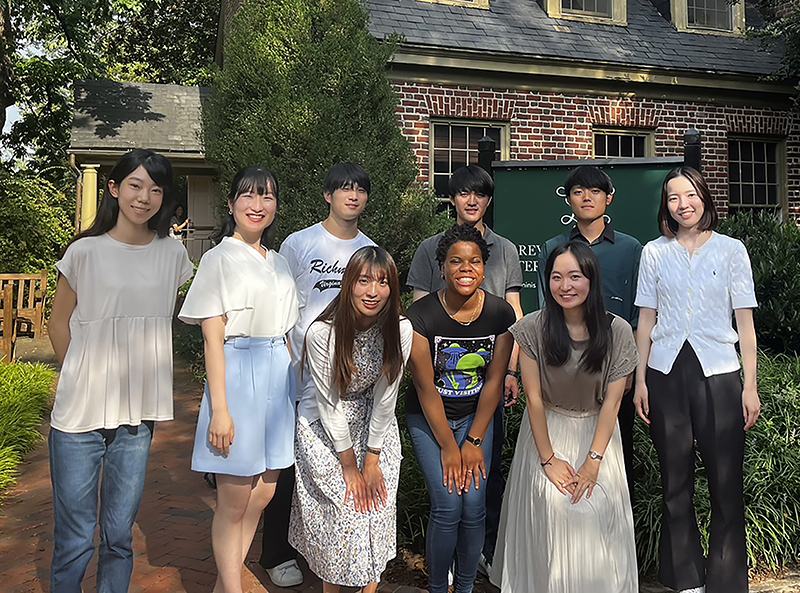Keio program maintains longstanding impact
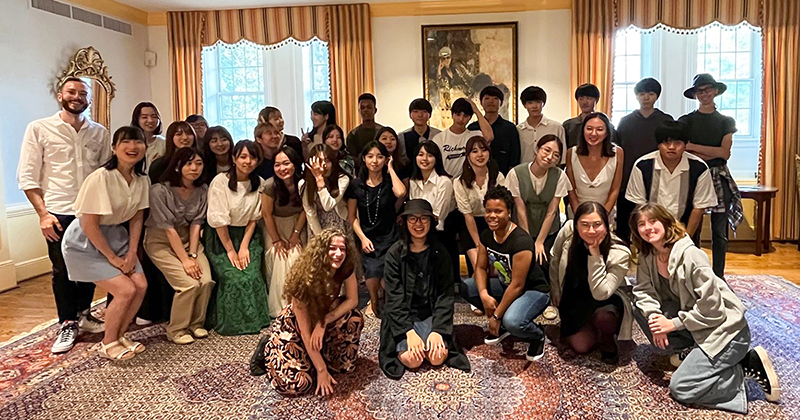 By Kate Hoving
By Kate Hoving
The Keio University/William & Mary Cross-Cultural Collaboration is a program centered on experiential learning which allows both Japanese and American students to study questions of cultural difference and national identity.
The program brings 25 to 40 Japanese university students to America for two to three weeks to study and experience first-hand American society and culture with William & Mary graduate and undergraduate students. Students attend lectures on a variety of topics including race, religion and pop culture while engaging with American culture firsthand through fieldwork activities such as trips to Colonial Williamsburg, Hampton Roads, Richmond and Washington, D.C.
A cutting-edge program when conceived in 1990, the Keio University/William & Mary Cross-Cultural Collaboration, has grown and evolved over the years to become an important part of the university's commitment to developing relationships with higher education institutions around the world.
Nasha Lewis, Associate Director of Global Education at the Reves Center, manages the Keio program. The 2023 program that ran in late August was the first in-person program since 2019 and involved 25 Keio students and 10 W&M student workers.
Lewis sees the benefits that both W&M and Keio students gain from the collaboration. “The Japanese students learn about American culture and share aspects of their own culture with fellow program participants. It’s a great networking opportunity for them,” she explains. And for the W&M student assistants and directors, “They take a deep dive into aspects of American history and culture that they may not have previously explored. The W&M students can compare and contrast American and Japanese cultures along with the Keio students. It’s an opportunity for them to learn and network as well.”
As Lewis notes, the program changes each year depending on the desires of the Keio students and the W&M Academic Director. “I enjoyed the visits to Canon and Lockheed Martin in 2018 and 2019 respectively. The group toured the companies and got a brief look behind the scenes. Those were memorable experiences for me, too.”
Morgan Brittain, PhD Candidate in American Studies, was the Academic Director Lewis hired for 2023, and he will serve in that role again this summer. It’s the kind of program that appeals to him. “I’m constantly thinking about cross-cultural relationships in my research and academic work, and it felt like a perfect fit to work with this program helping to build those kinds of connections.”
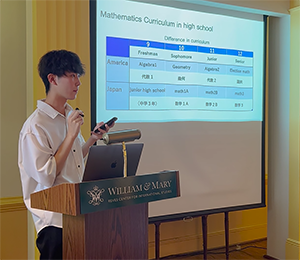 For the curriculum he devised, Brittain drew from expertise across the university. William & Mary professors from a range of disciplines gave lectures geared to various themes, including: Anthropology Professor Martin Gallivan (Indigenous People in Virginia); Charles McGovern, Director of American Studies and Associate Professor, American Studies and History (Global American Culture); Elizabeth Losh, Duane A. and Virginia S. Dittman Professor of English & American Studies (Social Media and the Rise of Far Right Politics); and Leisa Meyer, Professor of American Studies, History, and Gender, Sexuality and Women Studie (Gender and Sexuality in the U.S.). The students also explored topics ranging from race relations to contemporary music, with a mix of lectures, site visits and field trips.
For the curriculum he devised, Brittain drew from expertise across the university. William & Mary professors from a range of disciplines gave lectures geared to various themes, including: Anthropology Professor Martin Gallivan (Indigenous People in Virginia); Charles McGovern, Director of American Studies and Associate Professor, American Studies and History (Global American Culture); Elizabeth Losh, Duane A. and Virginia S. Dittman Professor of English & American Studies (Social Media and the Rise of Far Right Politics); and Leisa Meyer, Professor of American Studies, History, and Gender, Sexuality and Women Studie (Gender and Sexuality in the U.S.). The students also explored topics ranging from race relations to contemporary music, with a mix of lectures, site visits and field trips.
Although he was not a stranger to cross-cultural educational experiences, the intensity and pace of the Keio Program was a new experience for him.” I’d had several Japanese students in my classes, and at a previous institution, I taught Asian art and culture, so I knew about some aspects of Japanese culture. At the same time, though, there’s something particularly special about this program in which thinking about, discussing, and exchanging aspects of Japanese and U.S. culture are almost constant. Two weeks isn’t all that long, but I don’t think anyone who was part of the program—staff or student—would tell you they didn’t come away at least a little bit better.”
Lewis hires William & Mary graduate students to be classroom instructors and undergrads as peer assistants. The instructors lead discussions based on faculty lectures. In addition, they read and grade journals and other projects, supply thoughtful and constructive feedback to students to promote their use of the English language and understanding of American culture, participate in afternoon and evening cultural and social activities, and supervise and provide leadership to one or two W&M undergraduates who, as peer assistants, assist the Keio students with their projects and other related tasks.
Monet Watson, a graduate student in anthropology, served as a classroom instructor. She had no background with Japanese students or traveling to Japan, but she took to the role, helping them understand lectures and leading discussions about the day’s topics. She also graded journal submissions and gave feedback and guidance on projects.
It turned out a large part of her role was supporting them and helping them to get more comfortable with sharing information about themselves, and that meant the most to her. “Talking and being with the students was the most gratifying part of the program,” she recalls.
Alex Nakamitsu ’26, a philosophy major, was a peer assistant.
“I’m half Japanese, was born in Japan, and lived there until I moved to the U.S. when I was four,” Nakamitsu explains. “I never had a chance to make lasting friendships and build a social connection with my home country. I applied to work on the Keio Program because I wanted to meet Japanese students and make friends. I’m also very proud to be a William & Mary student and wanted to share my college experience with the Keio students.”
Nakamitsu echoes the aspect of the program that Lewis described—that W&M students were learning alongside the Keio students. She considers the day trip the group took to Richmond a highlight of the program for her. “We visited the Virgnia Museum of History and Culture and Belle Isle. I got to learn more about Virginia history that I'd previously known very little about (I’m originally from New Jersey).”
The short length of the program required an energetic pace, but it didn’t detract from the experience. “I was surprised at how engaged and excited the Keio students were about seeking out new experiences. Two weeks is a relatively brief time to study abroad, especially if you’re trying to learn as much as possible about the country you’re in,” says Nakamitsu. “Even during our free time, we were always going out and doing something, like shopping or going to the movies. Even though I wasn’t required to go, their excitement and enthusiasm made me want to go with them.”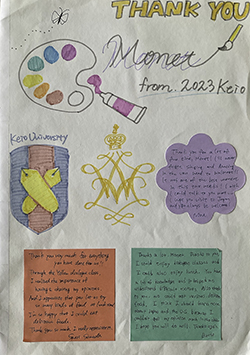
The connections were heartfelt and deep for both students and counselors, and there were tears and gifts exchanged when it came time for the students to go back to Japan.
Watson was a little surprised, in fact, by the impact. “We had a very tearful goodbye. The students created individual books filled with their comments or observations about us that they enjoyed. They gave us lots of gifts, and it wasn’t until that moment I understood the impact I had on them.”
Nakamitsu also has fond memories of the program and the students she met. “I remember getting really emotional on the last day of the program when the students surprised all the W&M staff with goodbye cards. I consider the students in my focus group my friends, and I even got to see them when I went to Japan this past winter.”
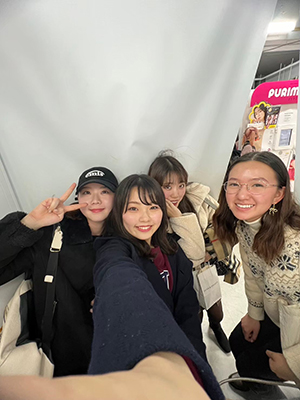
For Brittain there were many memorable aspects of the experience. “ Of course, we carefully planned the program to be memorable. Anyone who’s been in a higher ed classroom has experienced the collective ‘Ohhh!’ that signals simultaneous understanding. It’s hard to beat.” But he goes on to talk about an unplanned moment that had a special impact. “It was toward the end of the program, and the students and staff had all been working hard. The students were juggling lectures and discussion and preparing their focus group presentations on an aspect of American culture. The staff had been deeply engaged teaching and mentoring the students and keeping the program running smoothly. A big group of us decided to go for ice cream at Shoofly. We had a terrific time enjoying our sweet treats, singing along (in my case, very badly) to Miley Cyrus’s “Flowers,” and drawing and writing on the pavement with sidewalk chalk.”
He explains: “A big thing that makes this program so remarkable is that it brings together a group of cool and curious students (Keio and W&M) that are genuinely interested in forming connections, and when you do that, it creates opportunities for spontaneous joy.”
